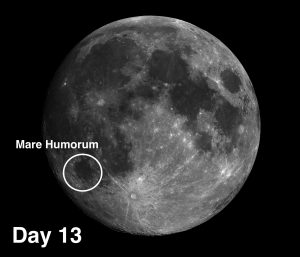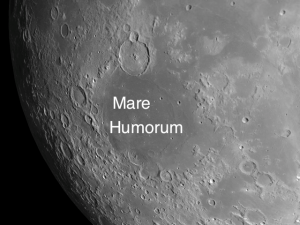The week of January 6-12 takes us from Day 11 to Day 17. This week we will highlight Mare Humorum, viewable for the whole week beginning on Monday evening.
 Mare Humorum: [SW/M6] The Humorum basin is one of the best examples of subsidence that you can see on the Moon. As the basin sank under the weight of its lavas, arcuate cracks, which can be easily observed in small telescopes, opened up on the east side around Hippalus and on the west side. The craters Doppelmayer, Lee, Hippalus, and Loewy tilted inward and their seaward rims sank beneath the lava flows which covered Mare Humorum.
Mare Humorum: [SW/M6] The Humorum basin is one of the best examples of subsidence that you can see on the Moon. As the basin sank under the weight of its lavas, arcuate cracks, which can be easily observed in small telescopes, opened up on the east side around Hippalus and on the west side. The craters Doppelmayer, Lee, Hippalus, and Loewy tilted inward and their seaward rims sank beneath the lava flows which covered Mare Humorum.
 Look closely at the Hippalus rilles just east of the mare. Notice how some of them plough through both mountain ridges and craters, and some are interrupted completely by small craters but continue on the other side. This gives you a clear indication of the sequence of activity. What features were in place before Humorum filled with lava and subsided? What features appeared after subsidence took place?
Look closely at the Hippalus rilles just east of the mare. Notice how some of them plough through both mountain ridges and craters, and some are interrupted completely by small craters but continue on the other side. This gives you a clear indication of the sequence of activity. What features were in place before Humorum filled with lava and subsided? What features appeared after subsidence took place?
OF ADDITIONAL INTEREST – 410th Anniversary of One of the Greatest Scientific Discoveries Ever Made
Tuesday is the 410th anniversary of one of the greatest scientific discoveries ever made, when Galileo took his new telescope (which he called his perspicil), trained it on Jupiter, and discovered that Jupiter had four moons. Up until that time the Church and the universities had insisted that the Earth was the center of all movement. Galileo’s discovery was proof that that was not the case, and got him into a lot of hot water (he was eventually tried for his “heretical” beliefs and sentenced to house arrest for the remainder of his life). I once saw a painting of Galileo standing on his balcony with his telescope pointed at Jupiter. There were four Cardinals of the Church with him, but they refused to so much as bend over and look through his telescope because they knew what they would find.
You can repeat Galileo’s discovery with even the smallest of telescopes (but you’ll have to wait a few months, as Jupiter is close to the Sun).
======================
It is highly recommended that you get a copy of Sky and Telescope’s Field Map of the Moon, the very finest Moon map available for use at the telescope. It is available for $10.95 at www.skyandtelescope.com and on Amazon. All features mentioned in this blog will be keyed to the grid on the Field Map and will look like this: Plato: [NW/D9]
Credits:
Courtesy of Gray Photography of Corpus Christi, Texas
Lunar photos: NASA / USGS / BMDO / LROC / ASU / DLR / LOLA / Moon Globe. Used by permission
- Rupes Cauchy: A Best Known Fault on the Moon - July 22, 2024
- Moon Crater Schickard – Crater Floor has Stripes - July 15, 2024
- Moon Craters Langrenus and Vandelinus - July 8, 2024